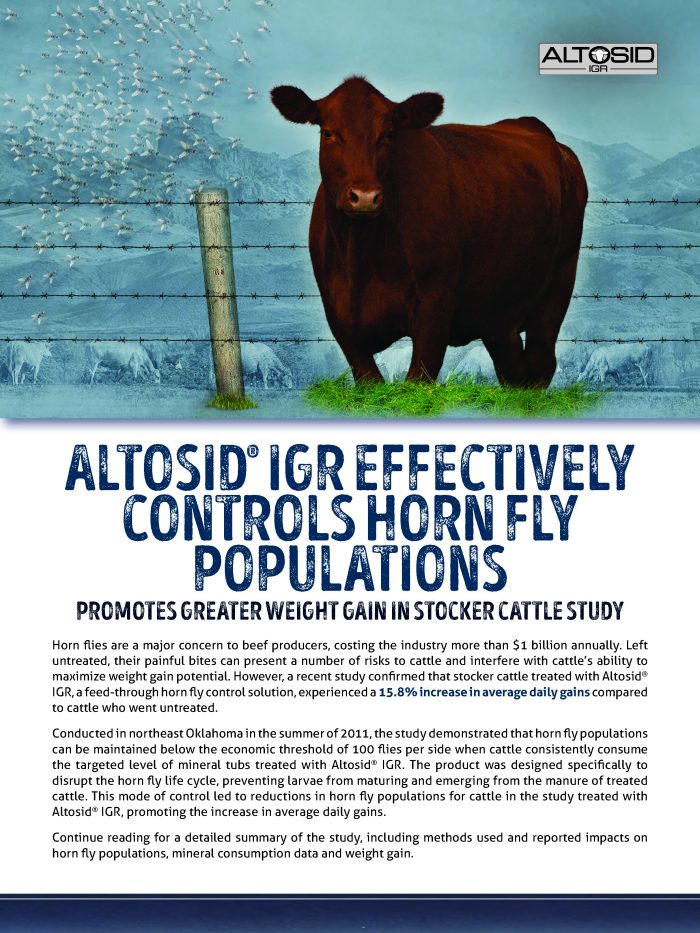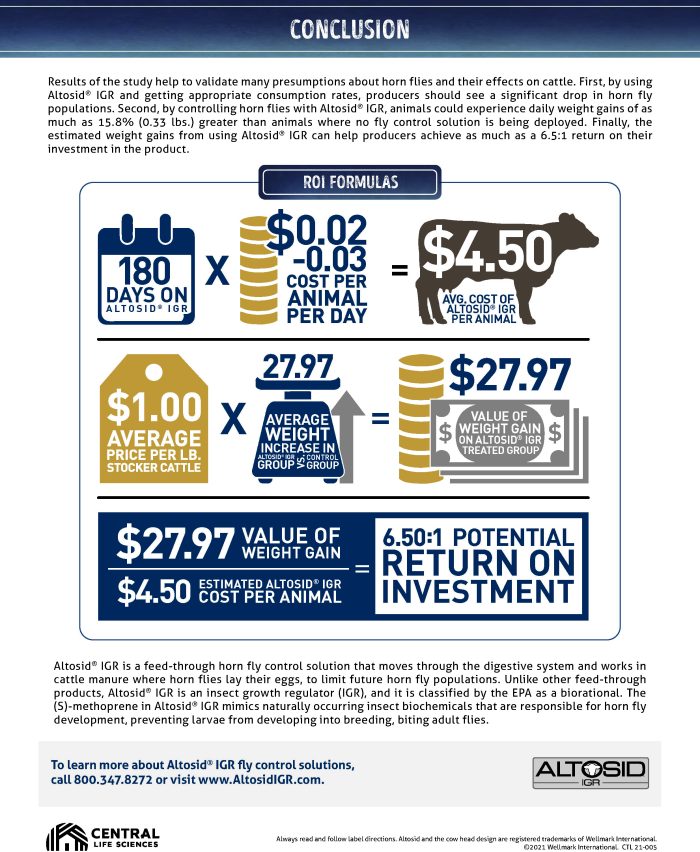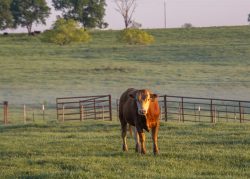







Remove the guesswork from choosing the best fly control for cattle
Use these tips to sift through fly control options for cattle on pasture.
Article and photos courtesy of Purina Animal Nutrition LLC
Transforming Cattle Health and Profitability with Horn Fly Management
Article and photos courtesy of Central Life Sciences
Found on the backs of cattle, horn flies are the most pervasive and costly external parasites of cattle in North America, taking up to 40 blood meals a day. Losses from horn flies cost the industry an estimated $1 billion each year due to the stress they inflict and diseases they spread to cattle. Using a fly management program to limit flies on cattle will help promote herd health.
The Impact of Horn Flies
Effects from horn flies on cattle include:
• Irritating cattle with their painful bites causing cattle stress and annoyance
• Burning excess energy to dislodge flies and cattle bunching, leading to interrupted grazing patterns
• Reducing weight gains and calf weaning weights
• Decreasing milk production
The diseases that horn flies spread to cattle, including beef heifer mastitis, can be linked to lower conception rates. Studies have confirmed that cows with infections can take 25% longer to conceive.
Beef heifer mastitis is a potentially devastating issue for cattle herds, as it can quickly spread and have a significant impact on both animal health and your bottom line. Mastitis, characterized by the inflammation and infection of one or more teats, often leads to the development of blind quarters. This condition, while often overlooked, can destroy the milk-producing tissues within the affected teats, ultimately resulting in decreased milk production and reduced weaning weights.

Horn flies are known to feed on the blood vessels in the skin of the teats, causing irritation and creating a gateway for mastitis-causing bacteria. Horn flies can carry these harmful bacteria from one animal to another, entering the teat orifice and moving upward within the quarter, where they inflict damage on the milk-producing tissues. These flies only leave the animals to lay their eggs in fresh manure, perpetuating the cycle of infection and infestation.
According to Dr. Nickerson at University of Georgia, 75% of all heifers have mastitis before they calve. He attributes 50% of that mastitis to the horn fly. By implementing an effective fly control program and incorporating Altosid® IGR to help prevent cases of mastitis, you can improve the overall health of the herd, particularly among the heifers.
The Horn Fly Life Cycle
To better control fly populations and protect against cattle diseases, it’s essential to understand the horn fly life cycle:
• Day Zero: Female adult flies leave the backs of cattle briefly to lay their eggs in fresh manure.
• Day 1-2: Eggs hatch into horn fly larvae.
• Day 3-8: Larvae molt into pupae.
• Day 9-17: Pupae molt into adults.
• Day 18-40: The adult horn fly emerges as a small, black insect, approximately 4 millimeters long. The adult can live anywhere from 2 to 4 weeks.
While the total life span of horn flies is slightly longer than one month, their populations expand quickly, causing infestations. In untreated herds, fly infestations can increase rapidly to upwards of 4,000 flies per animal.
Implementing proper practices and preventative fly control strategies is key to protecting your herd and profit from horn flies. Altosid® IGR is a feed-through fly control solution that passes through the digestive system and works in cattle manure where horn flies lay their eggs, limiting future populations from emerging. The active ingredient in Altosid® IGR mimics naturally occurring insect biochemicals that are responsible for insect development. The most effective way to control fly populations is to interrupt their life cycle. And Altosid® IGR, from Central Life Sciences, does just that while also eliminating the expense, labor and stress on your cattle associated with other fly control methods.
The 30/30 Program
Disrupting this life cycle is an essential component of controlling horn flies. By adding Altosid® IGR 30 days before fly emergence and continuing throughout the season until 30 days after the first frost, you can help prevent the spread of infectious diseases in cattle.
 The 30/30 Program recommends the use of Altosid® IGR to control fly populations. Producers should start including these products in their feed or supplement early in the spring, 30 days before flies begin to appear through 30 days after the first frost when cold weather reduces or ends fly activity. This time frame ensures an ideal window of treatment with the products, protecting against an unpredictably early or late start to the spring or winter seasons.
The 30/30 Program recommends the use of Altosid® IGR to control fly populations. Producers should start including these products in their feed or supplement early in the spring, 30 days before flies begin to appear through 30 days after the first frost when cold weather reduces or ends fly activity. This time frame ensures an ideal window of treatment with the products, protecting against an unpredictably early or late start to the spring or winter seasons.
To limit the population of overwintering flies that emerge in spring and mark the start of fly season, producers should follow the key steps of the 30/30 Program:
• Begin feeding Altosid® IGR 30 days before average daytime temperatures reach 65° F.
• Continue the process until 30 days after the first frost in the fall.
Numerous studies have highlighted the severe economic damage that flies can cause to both dairy and beef operations. Therefore, it is essential to control fly populations. By adopting a “30/30” approach, producers can get ahead of the fly population in the spring before it builds up to a level that exceeds the economic threshold.
By continuing to feed 30 days past the average first frost date in the fall, producers can reduce the total number of overwintering pupae, giving them a head start on the population for the following year. When incorporated into a complete Integrated Pest Management (IPM) program, the use of Altosid® IGR with a “30/30” approach can help producers account for the unpredictability of the seasons and significantly lower fly populations while increasing cattle comfort and profitability.
Integrated Pest Management
The key component to start any IPM program is the initial Planning phase, which includes the identification of problem pests, understanding their habits and devising a management strategy. Once the target pests have been identified, a successful IPM strategy must advance to the Implementation phase, approaching pest control through a combination of several complementary methods.
To have a complete program, one should include several of the following tactics:

1. Improve cultural practices to reduce fly resting, feeding, and breeding sites through regular cleaning and upkeep of facilities and surrounding vegetation. Effective fly control begins with cultural practices, particularly in managing cattle manure. Flies breed in manure, emphasizing the importance of proper manure management.
2. Incorporating natural enemies of flies, such as parasitic wasps and predatory beetles, constitutes biological control. This method helps limit fly populations without adverse effects on animals or humans. By enhancing the ecosystem’s natural balance, biological control is an eco-friendly approach to pest management.
3. Incorporate various physical techniques, like fly traps and sticky tapes to remove adult flies that migrate from surrounding areas and help monitor the amount of fly activity.
4. Using targeted products to control flies like Altosid® IGR, a feed-through fly control product. This product delivers a key active ingredient to cattle, disrupting the fly life cycle in manure and preventing the emergence of adult horn flies.
While establishing a solid Integrated Pest Management (IPM) program is crucial, the journey doesn’t stop there. Ongoing monitoring is just as vital. Regularly assessing fly populations using speck cards and fly traps allows cattle operators to fine-tune their strategies, maximizing control efforts.
For maximum effectiveness, Altosid® IGR should be used as the foundation of an Integrated Pest Management (IPM) program, including proper sanitation, maintaining physical structures, incorporating naturally occurring fly enemies and using chemical controls. Given the role flies play in cow health and conception, implementing proper practices and preventative fly control strategies is key to protecting your herd and profit from horn flies.
To learn more about Altosid® IGR fly control solutions, call 800.347.8272 or visit www.AltosidIGR.com.
Altosid is a registered trademark of Wellmark International.